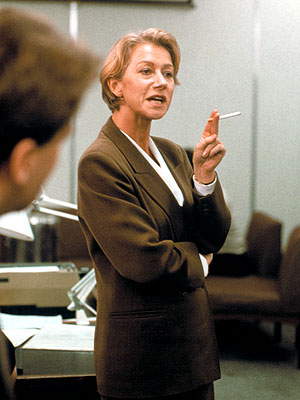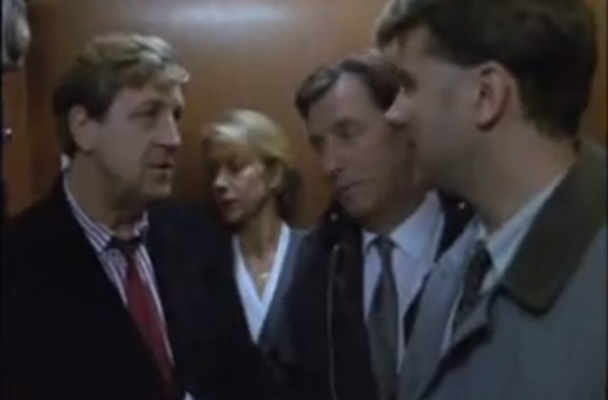Author’s Note: Welcome to our weekly feature on Prime Suspect, the renowned British police series, where we’ll delve into the life and cases of Detective Chief Inspector Jane Tennison.
Currently, the plan is to address one segment of each series per week, mirroring their original broadcast schedule.
All seven series are accessible on DVD and in fragments on YouTube, with Amazon Instant Video also offering the show (italicized). With seven series, each divided into one to four parts, this should ideally provide us with three to four months of material.
However, I might consolidate some segments if I find that there isn’t enough to discuss in a particular installment.
As mentioned below, I’m watching these series for the first time myself, and I’m uncertain about the direction the story will take.
For now, let’s begin with the first series’ first part and assess our initial impressions. Next week, on June 20, we’ll return to examine the second half, delving into the broader aspects of the investigation and the show’s well-known portrayal of institutional sexism.
Prime Suspect
Series 1, Episode 1
Original airdate: April 7, 1991
How many times have we witnessed this scenario before? Facing a shortage of original hits and aiming to tap into the nostalgia market, one of the major networks invariably attempts to revive, reboot, or reanimate a show from yesteryears, updating its narrative for contemporary times and reimagining iconic roles with a handful of marketable stars.
On occasion, this strategy succeeds—recent instances like Battlestar Galactica and Hawaii Five-0 come to mind.
Yet, more frequently than not, we end up with a Bionic Woman or Charlie’s Angels, a venture that falters because nostalgia can only conceal a subpar show for so long.
In the autumn of 2011, NBC embarked on its own resurrection endeavor with Prime Suspect.
Most of you are already familiar with the backstory: it was one of Robert Greenblatt’s initial attempts to leave his mark on NBC.
Unfortunately, it failed to find a substantial viewership* and limped through thirteen episodes in the challenging Thursday night 10 p.m. time slot before ultimately being replaced by The Firm.
Nevertheless, it gradually transformed into a commendable police procedural, thanks in large part to Maria Bello’s commanding lead performance and a squad of characters who evolved into more nuanced figures over time.
*A lot of people blamed the hat, but I’m on record that it was a good prop, and Bello used it to admirable effect. It’s a hat; she wears a hat now. Hats are cool.
However, at the outset, many critics didn’t label it as a terrible show; rather, their complaints centered around their perception of the source material as sacred.
Showrunner Alexandra Cunningham based her series on a British counterpart bearing the same name, which enjoyed a seven-season run from 1991 to 2006.
Also Read: Review: Prime Suspect, Series 1, Part 2
Prime Suspect isn’t just any television show; it holds the status of a classic, boasting a collection of prestigious awards, including Emmy Awards, Golden Globe Awards, BAFTA Awards, and a Peabody Award.
Furthermore, it’s considered one of the cornerstones of character-driven police dramas—Alan Sepinwall of HitFix even went so far as to suggest in his initial review of the remake that “American cop show producers can recite it verbatim.”
As for myself? I had never even come across it. Thus, when This Was Television made its selection for the initial set of shows to explore, Prime Suspect topped my list.
In embarking on this journey, my aim is to delve into why this show enjoys such reverence in the realm of police dramas, where its central character, Jane Tennison, ranks among fictional law enforcement figures, and to what extent contemporary police dramas owe their existence to the groundwork laid by Lynda La Plante and her team.
At the very least, it presents an opportunity to appreciate Helen Mirren’s talent for several hours, and I can’t imagine anyone declining that offer.
So, let’s dive into the first episode. From the perspective of a modern audience, such as myself, the show’s premise appears to follow a relatively standard police procedural formula.
A deceased body is discovered in a prostitute’s apartment, prompting the involvement of the police, who commence their investigation.
Thanks to the rarity of a particular blood type, a suspect is swiftly identified—an additional twist being that he’s a previously convicted rapist. However, the available evidence proves insufficient for a conviction, forcing them to release him temporarily.
Almost immediately thereafter, a second body is found, further complicating matters.
The investigation continues to progress, and a stroke of luck occurs when an unexpected witness emerges, redirecting suspicion back towards our initial suspect.
The procedural aspect feels familiar, yet several elements begin to set it apart as something distinctive. Foremost among them is Helen Mirren in the role of Detective Chief Inspector Jane Tennison.
As one of the very few female DCIs in all of London, Tennison has risen through the ranks based on her own merits but has been bogged down by paperwork ever since reaching her current position.
The series not only focuses on the investigation but also on Tennison’s personal journey. She battles to be granted control of the investigation after the original DCI, John Shefford, suffers a heart attack.
Following her appointment, she faces the uphill battle of earning the respect of the predominantly male squad room, a challenge further complicated by the embittered partner of the ailing Shefford, Bill Oatley (portrayed by Tom Bell).
In a fascinating stylistic choice, the show doesn’t initially center on her character but rather on Shefford’s investigation and the subsequent arrest and interrogation of the prime suspect, George Marlow (played by John Bowe).
We don’t get to spend an extended amount of time with her until fifteen minutes into the first part.
When we do, it’s in a scene where she’s dealing with her boyfriend, Peter (portrayed by Tom Wilkinson), and his visiting son while attempting to maintain control, even with half a chocolate cake smeared on her blouse.
The show even employs technical methods to downplay her presence at the outset.
In one early scene, Shefford and Oatley ride an elevator with her standing directly behind them as they discuss Marlow’s criminal record, yet they don’t even acknowledge her presence until she exits on her floor.
However, once Tennison assumes her role, the narrative thrusts her character into the forefront, and she demonstrates that after being ignored for so long, she’s not going to yield easily.
Mirren’s portrayal of Jane Tennison is nothing short of remarkable, projecting an unwavering sense of professionalism that she knows is crucial for gaining respect.
If she can’t win people over, she’s willing to settle for their respect, as she firmly articulates to Oatley during their initial briefing: “All I ask is your undivided loyalty and attention… If you don’t like it, request a transfer.”
This character exudes an unyielding determination, evident in her interactions with her fellow squad members and during various interrogation scenes.
Her demeanor is so resolute that even one of the interviewees, the victim’s boyfriend clad in leather, leaves the room in tears, questioning, “What kind of person are you?” while she calmly lights a cigarette afterward.
*A leather-jacketed boyfriend played by none other than a very young Ralph Fiennes. If you ever wanted to see a young Voldemort squirm, here’s your chance.

However, she’s not impervious. Her performance is filled with many human moments, particularly when she allows herself to lower her guard.
An early scene where she meets with her superior after being assigned to the investigation, raises her fists, and softly exclaims, “Yes!” is a sheer delight to witness.
Her frustration with the investigation occasionally bubbles over, leading to moments of snapping at her male colleagues when they hinder her progress.
There are even instances of childish pouting when minor setbacks occur, such as her first TV interview being mistakenly recorded. Tennison isn’t a superhuman detective; she’s an individual striving to prove herself in an intensely competitive environment.
The show makes a concerted effort to depict both facets of her character, especially in a poignant monologue where she reveals the extent of her emotional connection to the victims.
“At that moment, I feel like a pain. I feel it, and I hold onto it because it’s up to me to find the man who shattered that life.”
*A line that may not have been humorous at the time but certainly takes on a different meaning in a contemporary context: In her quest to earn respect, Tennison requests that her male colleagues stop addressing her as ‘mum,’ shouting, “I’m not the bloody Queen!” Fast forward fifteen years, and her perspective has evolved.
Another aspect that makes Prime Suspect exceptionally gripping from the outset is, paradoxically, its deliberate pacing. Part one spans a lengthy 104 minutes, exceeding the duration of two typical episodes in an hour-long drama series.
By the episode’s conclusion, the investigation has only progressed as far as a lineup that may or may not result in Marlow’s return to prison. The investigation extends over several days, with leads dwindling and potential interviewees becoming scarce.
This situation reaches a point where the failure to locate Marlow’s car becomes a recurring source of frustration and humor within the office, with the constant refrain being, “Anything on Marlow’s car? No, of course not.”
This protracted case approach can be a risky choice in cop dramas (as demonstrated by the backlash The Killing faced in the previous year). However, Prime Suspect skillfully employs its extended runtime to its advantage.
As the investigation drags on, the relationship between Tennison and Oatley becomes increasingly tense, with his attempts to undermine her clashing with her innate determination and the concealed information she uncovers about Shefford.
The show’s minimalist stylistic choices, including the grainy made-for-TV video quality, contribute to the overall atmosphere.
These choices enhance the gritty ambiance of the police station and accentuate the growing sense of paranoia on both sides as the investigation unfolds.
The most significant distinction here lies in the fact that we’re not just witnessing an investigation unfold but also observing the toll it takes on the individuals involved.
Our initial glimpses of Tennison’s harmonious relationship with Kevin before the murder take on a deeper poignancy as we witness how it unravels under the strain of her new position, especially as her unintentional neglect accumulates (“Anything you do is important, anyone else’s actions are not important?” Kevin wearily remarks while she remains fixated on rewatching her interview tape).
In a unique structural choice, we also gain insight into Marlow’s home life and the strain the investigation places on his marriage. We spend a significant amount of time with the suspect, all the while uncertain if he’s truly the killer.
This adds to the atmosphere of uncertainty and tension regarding how diligently Tennison and her team are striving to secure Marlow’s conviction; a tension further intensified by the raw desperation that John Bowe imbues into his portrayal.
So, there are numerous intriguing elements at play here from the outset, and deeper layers are likely to unfold in the next episode when we discover whether Marlow is guilty and, if so, whether Tennison can make the charges stick.
Join us again on June 20th for part two of the series as we witness the conclusion of the investigation.


